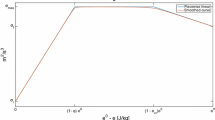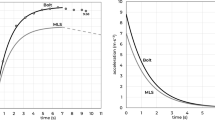Abstract
A simple mathematical model for competitive running is developed. This model contains the force and energy reserves as key variables and it describes their relationship and dynamics. It is made up of three submodels for the biomechanics of running, the energetics and the optimization. The model for the energetics is an extension of the hydraulic model of Margaria and Morton. The key geometric parameters of this piecewise linear, three compartment model are determined on the basis of well known physiological facts and data.
Similar content being viewed by others
References
Ballreich, R.: Weg and Zeitmerkmale von Sprintbewegungen. Berlin: Bartels and Warnitz Vlg 1969
Baumann, W.: Kinematic and dynamic characteristics of the sprint start. Biomechanics VB. (Int. Ser. Biomech., vol. Vb, pp. 194–199) Baltimore: University Park Press 1973
Behncke, H.: Optimization models for the force and energy in competitive sports. Math. Meth. Appl. Sci. 9, 298–311 (1987)
Cavagna, G. A., Kaneko, M.: Mechanical efficiency in level walking and running. J. Phys. 268, 467–481 (1977)
Davies, C. T. M.: Wind resistance and assistance in running. Med. Sport 13, 199–212 (1981)
di Prampero, P. E., Pifiera Limas, F., Sassi, G.: Maximal muscular power, aerobic and anaerobic in 116 athletes performing at the 19th Olympic Games in Mexico. Ergonomics 13, 665–674 (1970)
Filipov, A. F.: On certain questions in optimal control. Siam J. Control 2, 76–84 (1962)
Fukunaga, T., Matsuo, A., Yuasa, K., Fujimatsu, H., Asahina, K.: Mechanical power output in running. Biomechanics VIb. (Int. Ser. Biomech., vol VIb) Baltimore: University Park Press 1978
Heck, H.: Laktat in der Leistungsdiagnostik. Schorndorf: Hoffmann 1990
Hirvonen, J., Rehunen, S., Rusko, H., Härkönen, M.: Breakdown of high energy phosphate compounds and lactate accumulation during short supramaximal exercise. Eur. J. Appl. Physiol. 56, 253–259 (1987)
Hellmann, W., Hettinger, T.: Sportmedizin - Arbeits- und Trainingsgrundlagen. Stuttgart New York: Schattauer 1980
Keller, J. B.: A theory of competitive running. Phys. Today 26, 43–47 (1973)
Kindermann, W., Keul, J.: Anaerobe Energiebereitstellung im Hochleistungssport. Schorndorf: Hoffmann 1977
Knuttgen, H. G., Vogel, J. A., Poortmans, J.: Biochemistry of Exercise. In: Proc. of the Fifth Intern. Symposium on the Biochemistry of Exercise, Boston 1982. Champaign, IL: Human Kinetics Publ. Inc. 1982
Mader, A.: Eine Theorie zur Berechnung der Dynamik und des steady state von Phosphorylierungszustand und Stoffwechselaktivität der Muskelzelle als Folge des Energiebedarfs. Habilitationsschrift -Deutsche Sporthochschule Köln (1984)
Margaria, R.: Biomechanics and energetics of muscular exercises. Oxford: Clarendon Press 1976
McGilvery, R. W., Murray, T.: Calculated equilibria of phosphocreatine and adenosin phosphates during utilization of high energy phosphate by muscle. J. Biol. Chem. 18, 5845–5850 (1974)
Morton, R. H.: A three component model of human bioenergetics. J. Math. Biol. 24, 451–466 (1986)
Morton, R. H.: Modelling human power and endurance. J. Math. Biol. 28, 49–64 (1990)
Morton, R. H.: Model theory equations for maximal power and endurance. (Preprint 1988)
Neustadt, L.: Optimization. Princeton: Princeton University Press 1976
Taylor, C. R., Schmidt Nielsen, K., Raab, J. L.: Scaling of energetic cost of running to body size in mammals. Am. J. Physiol. 219, 1104–1107 (1970)
Ward-Smith, A. J.: A mathematical theory of running, based on the first law of thermodynamics and its application to the performance of world class athletes. J. Biomech. 18, 337–349 (1985)
Zaciorski, V. M.: Biomechanische Grundlagen der Ausdauer. Berlin: Sportverlag 1987
Author information
Authors and Affiliations
Rights and permissions
About this article
Cite this article
Behncke, H. A mathematical model for the force and energetics in competitive running. J. Math. Biol. 31, 853–878 (1993). https://doi.org/10.1007/BF00168050
Received:
Revised:
Issue Date:
DOI: https://doi.org/10.1007/BF00168050




